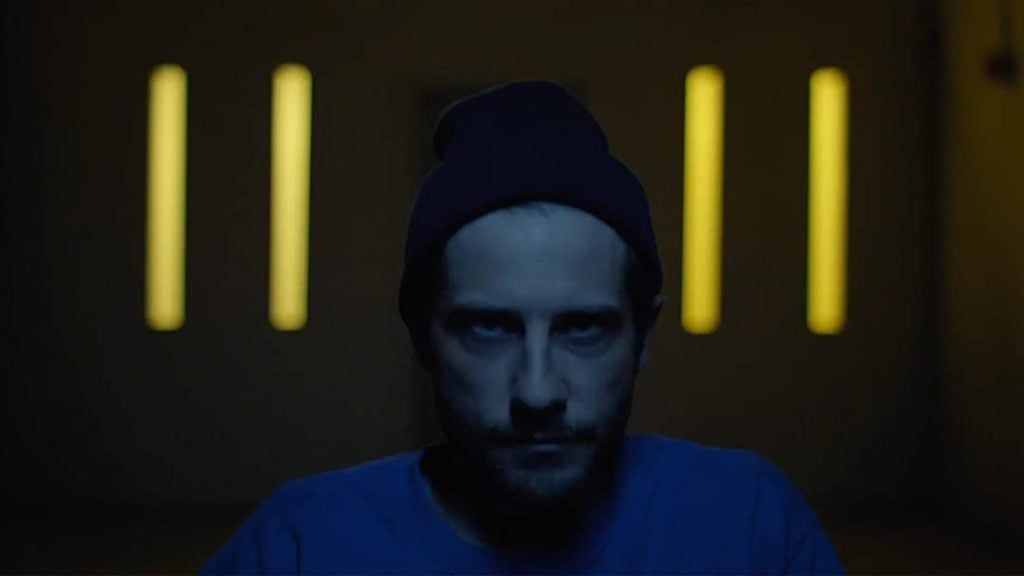When sleep is unattainable, the minutes seem to stretch into hours. The walls within our minds crumble as the night wears on, and hidden fears and secrets are able to spill out into our consciousness. Loneliness is amplified; if there is someone sleeping beside you, they often seem in another world that is unreachable. Life for Saul is an endless night. He is left to his own devices while the world around him slumbers, blissfully unaware of just how painfully long and lonely night time can be. In Saul at Night, first time director, Cory Santilli, and first time writer, Daniel Miska, explore an eerie world of isolation in darkness. In this reality, a sleep curfew exists where everyone is fast asleep at 10:00 pm, but Saul, played by Kentucker Audley, begins his day at this time. He ends it hearing the loud ring of a phone at 6:00 am which culminates in an automated message being left on an answering machine, declaring all citizens must now be awake.
Despite living with them in the same house, Saul never sees his wife, Kathryn (Stephanie Ellis), and his daughter, Cleo (Acadia Colan), awake. Thus, he never speaks to them, never looks into their eyes, and is never able to hear a surprise jubilant laugh burst out of them in real time. He has missed out on the small nuances of human connection and interaction for over two years now, but he has found other ways to connect with his family. He has set up cameras around the common areas of the house to record them during their daily morning and evening routines. He also does small chores around the house like fixing a loose cabinet door and writes short notes for his daughter to take with her to school. The reasons why Saul volunteered for this bizarre experiment of reversing his sleep-wake cycle remain vague and unexplained. It’s unclear if the sleep curfew is in place across the entire country or just occurring in the unnamed city where Saul lives.

Just when the audience is led to believe that Saul is the only person awake at night, he spots a mysterious woman during one of his nightly outings named Amalur (Suzanne Clément). He is astounded and relieved, but, unfortunately, their first interaction is comedic in a sad way. It is reminiscent of The Twilight Zone episode where the man who desperately wishes to be alone to read is finally all alone with every book he could ever want, and then he trips and breaks his glasses. This moment between Amalur and Saul is frustrating and bittersweet. They might as well be the only two people left on Earth; they become each other’s lifelines. Saul soon learns that Amalur would rather not be constantly involved in her family’s life so that she can be spared the pain of watching her family go on living without her. She’d even rather pretend they don’t exist at times. While Saul has dealt with this situation in the complete opposite manner by always trying to remain involved in his wife and daughter’s lives. He desperately wants to interact with them in any way he can even if it means fabricating his own reality that includes replacement versions of Kathryn and Cleo. Amalur later remarks that Saul is a very good liar.
Even though we’re introduced to another character who is struggling like Saul, she is never quite as fleshed out as he is. Although, everything is from Saul’s perspective, so the audience is given less of a look into other characters’ lives. Even his wife and daughter are not shown in their busy lives outside of home. Viewers are only given the pieces of their lives that Saul is able to observe which mostly consists of them rushing around getting ready in the morning or eating dinner, always with a sleeping Saul not too far out of frame. The film is more of a character study of how both Amalur and Saul deal with isolation. They’re both like ghosts, haunting their houses and families. What is it like to be continually in the presence of others and yet still be completely alone? The emotional impact would have been strengthened with a look into these other characters’ emotions outside of what only Saul can observe. Amalur’s home life and much of who she is as a person is left unknown.

It’s hard not to see the exhausting and nonstop American work culture of today’s society bleed into the film. Commercials and billboards tout how people are happier and sharper with this sleep curfew in place and therefore more productive. Productivity is at an all time high since enforcing the curfew. In the real world, work life balance is often non-existent whether you’re working multiple jobs to make ends meet or working a job where you’re constantly on call. Fleeting and precious moments with your family or even just life in general are repeatedly missed. Saul mentions multiple times that he did what he had to do for his family. We’re given the impression that he and Kathryn discussed it before coming to the decision that he would volunteer, but they are now both regretting it. Life doesn’t stop just because you aren’t there to witness it, and that’s something Saul has painfully realized. Experiencing life from the outside looking in or from a screen, is no life at all. The film is a great example of how night shift work can strain both people’s psyches and personal relationships.
The entire cast gives exceptional performances that are often understated. Both Suzanne Clément and Kentucker Audley are able to effectively convey the quiet anguish and suffering of two people who are stuck in a twisted reality. Where it would be easy to be either too sinister or facetious, these two are more realistic and capture the small subtleties of people who are each grieving the loss of a normal life and happiness in some ways and are just trying to survive and get through their days the best way that they can. The interactions between these two and also Saul and his family were a joy to watch.
The whole film is not only darker and melancholic in tone but also visually. Much of the story takes place at night and in dimmer lighting. It’s in the middle of winter, and the days are shorter as well. Many of the colors are from a cooler palette and appear muted and dull. Everything almost looks as exhausted and drained as Saul must feel emotionally and physically. The visual darkness and sound design add to the creepiness of the film. There are plenty of quiet and almost peaceful moments that take place during Saul’s night shifts, but there is also an ever present feeling of unease simmering just underneath. The score accentuates this feeling as well as the moments where Saul is dealing with technology of some kind. Sudden loud, jarring, and aggressive noises disturb any cultivated peace that was once taking place, leaving the audience more on edge. It suggests that the entity running this experiment and sleep curfew may not exactly be non threatening. The computer that he must interact with daily is also seemingly slow on purpose and taunting in other ways.

This film brings up plenty of questions, but many of them are not answered. It is never really explained who both Saul and Amalur were before this and why they volunteered to do the experiment. Did Saul know or work for the entity conducting it? Why was it decided to conduct this experiment in the first place? The final scenes of the film are a bit ambiguous as well, so if you’re expecting answers while watching this, you likely won’t find them. It is a snapshot in time of this man’s life and as previously stated more of a character study, but it is sometimes difficult to be left with an overwhelming amount of questions by the end. It makes it harder to fill in the blanks on your own as a viewer. The questions that creep up throughout the movie can sometimes distract from getting lost in the emotional weight of the film which lessens the impact altogether.
Overall, the film is both fascinating and moving in parts. The idea of something controlling your brain and sleep cycles to the point where you involuntarily fall to the ground asleep at a specific time every day is a terrifying thing to think about. Watching Saul unravel under the heavy burden of his circumstance is painful to witness. It makes one question if maybe Amalur is either better equipped to deal with the situation or has chosen the better method to endure it. This is a reality that is worth exploring more in depth. Not every question has to be answered, but the emotional blows could have been enhanced with a bit more fleshing out of the environment, motivations, and the other characters surrounding Saul. The brief moments that Amalur, Kathryn, and Cleo have alone that don’t revolve around Saul, are some of the best scenes in the film because we’re given more of a window into who they are and their personal struggles. It’s a delicate balance to have enough exposition without causing the film to drag in places, but a few more explanations could have strengthened the story without slowing the pace down. The premise is unique and thought provoking, and it is a film that will most surely reward repeat viewings.
Saul at Night is currently available on Apple TV+, Amazon, and Altavod.
Director: Cory Santilli
Writer: Daniel Miska
Runtime: 1 hr 25 m
Rating: 3.5 out of 5
[youtube https://www.youtube.com/watch?v=KQNwvZ9E_YI]

When I’m not busy daydreaming or having an existential crisis, I can usually be found watching a movie or TV, listening to music or a podcast, or with my nose in a book.






![‘Frankenstein’ Review – Guillermo del Toro’s Definitive Look At The Nature And Nurture Of Monstrosity [TIFF 2025] ‘Frankenstein’ Review – Guillermo del Toro’s Definitive Look At The Nature And Nurture Of Monstrosity [TIFF 2025]](https://cdn.geekvibesnation.com/wp-media-folder-geek-vibes-nation/wp-content/uploads/2025/10/Frankenstein-175_PF_20240430_20377_R-300x200.jpg)